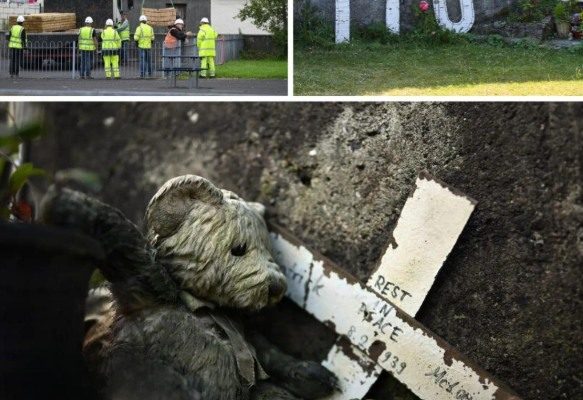Excavation has commenced on a septic tank at a location in Ireland, where authorities suspect the presence of the remains of nearly 800 deceased infants and children who perished at a home for unwed mothers operated by Catholic nuns.
Local historian Catherine Corless informed Sky News that many of the infant remains are feared to have been discarded in a cesspool referred to as ‘the pit’ at the former institution located in the small town of Tuam, County Galway. According to Corless’s research, a total of 798 children died at the home between 1925 and its closure in 1961, with only two being interred in a nearby cemetery. Significant quantities of human remains have been identified beneath the surface of this tranquil area in Tuam.
The land, associated with the nuns’ home from 1925 to 1961, remained largely undisturbed after the institution was demolished in 1972. The remains of the other 796 children are believed to lie beneath the site of the Bon Secours Mother and Baby Home, which was torn down in 1971 and is now encircled by a modern apartment complex.
Bon Secours, commonly referred to as The Home, served as a maternity facility for unmarried mothers and their offspring, managed by a religious order of Catholic nuns. Unmarried pregnant women were sent to the home to deliver their babies and were confined for a year to perform unpaid labor.
They were separated from their newborns, who were cared for by the nuns until adoption, often without the consent of their families. The full extent of the tragedy at Bon Secours was only revealed in 2014, thanks to Corless’s discoveries.
It was not until 2022 that legislation was enacted in Parliament to permit the commencement of excavation work at Tuam. Now, after more than a decade, a team of investigators has initiated their forensic examination this week.
It is anticipated that the process will take up to two years to identify the remains of the infants and provide them with a respectful reburial, offering some measure of closure to survivors. ‘I don’t care if it’s a thimbleful, as they tell me there wouldn’t be much remains left; at six months…
Following childbirth at the homes, mothers were subsequently separated from their offspring, frequently through adoption.
AFP via Getty Images
Her mother, Margaret “Maggie” O’Connor, gave birth to a daughter, Mary Margaret, at the home after being raped at the age of 17. Tragically, the girl passed away six months later, a fact her mother learned only when a nun informed her.
“She was hanging out the washing when a nun approached her and said, ‘the child of your sin is dead,’” recounted Annette, who currently resides in the UK. Bon Secours was merely one institution within a broader network of oppression in Ireland, the full extent of which has only come to light in recent years.
Mothers at Bon Secours who “reoffended” by having additional children out of wedlock were sent to Magdalene laundries, notorious Irish institutions for so-called “fallen women,” typically managed by Catholic orders but discreetly supported by the state. Initially, the term “fallen women” primarily referred to sex workers, but the Magdalene laundries eventually began to accept “seduced” women, victims of rape and incest, as well as female orphans or children abandoned or mistreated by their families. John was described as “a miserable emaciated child,” despite being born healthy a year prior.
AFP via Getty Images
The last of the Magdalene laundries only ceased operations in the 1990s. In 2014, Ireland’s government issued a formal state apology, and in 2022, a compensation scheme was established, which has thus far disbursed the equivalent of $32.7 million to 814 survivors. The religious orders that managed many of the laundries have declined requests from victims and Ireland’s Justice Minister to contribute to the program



